Summary
Male grasshoppers of the acridid speciesChorthippus biguttulus respond to conspecific female song by turning abruptly toward the sound source and then singing themselves. The orienting response requires that (i) the male recognizes the female song and (ii) determines the location of its source. By observing the effects of various forms of surgical interference (cutting connectives, splitting ganglia, destruction of a tympanal organ) on the subsequent behavior, we were able to narrow down the paths of information flow necessary for these abilities and to make an estimate of the contributions of individual ganglia to the evaluation of sound direction.
-
1.
The information from a single tympanal organ is sufficient for therecognition of the conspecific song. From the metathoracic ganglion (TG3) sufficient information for song recognition ascends both in the ipsilateral and in the contralateral connective chain. Thus, information for song recognition is transmitted to the opposite side within the metathoracic ganglion.
-
2.
For a singing response to be elicited by hearing a female chirp, it is necessary and sufficient that the connectives linking TG3 and the supraesophageal ganglion (brain) of the male be intact on at least one side (as has been shown forGomphocerippus rufus by Loher and Huber 1966, and Elsner and Huber 1969). Neither the three thoracic ganglia alone nor the thoracic-ganglion complex plus the subesophageal ganglion suffice to elicit either the turning or the singing response. The most probable explanation of our results is that the information paths for both responses make a loop via the brain.
-
3.
A crucial step in sound direction processing takes place within TG3 itself. The results after connective cutting indicate a reciprocally inhibitory interaction within this ganglion by which the difference between right and left tympanal input is enhanced.
-
4.
The information about sound direction carried in either connective alone is incomplete. Therefore, an additional ‘comparator element’ must exist, which receives the ‘directional signals’ from both connectives and converts them into an unambiguous turning command. This step in direction processing must occur either in the brain or along the pathways descending from the brain to the anterior two thoracic ganglia.
-
5.
The anterior two thoracic ganglia, as well as the subesophageal ganglion, make either no contribution or a negligibly small contribution to the determination of sound direction.
Similar content being viewed by others
Abbreviations
- CNS :
-
Central nervous system
- Brain :
-
Supraesophageal ganglion
- SOG :
-
Subesophageal ganglion
- TG1 :
-
Prothoracic ganglion
- TG2 :
-
Mesothoracic ganglion
- TG3 :
-
Metathoracic ganglion (including the first 3 abdominal ganglia, which are fused to it)
- TO :
-
Tympanal organ
- SA :
-
Stridulation apparatus
- TA :
-
Turning apparatus
- IRM :
-
Innate releasing mechanism
- LS :
-
Loudspeaker
- n :
-
Total number of stimulus (female chirp) presentations
References
Altman JS, Kien J (1979) Suboesophagial neurons involved in head movements and feeding in locusts. Proc R Soc London B 205:209–227
Autrum H (1936) Über Lautäußerungen und Schallwahrnehmung bei Arthropoden. Z Vergl Physiol 23:332–373
Bentley DR (1977) Control of cricket song pattern by descending interneurons. J Comp Physiol 116:19–38
Boyan GS (1983) Postembryonic development in the auditory system of the locust. J Comp Physiol 151:499–513
Boyan GS, Altman JS (1985) The suboesophagial ganglion: a ‘missing link’ in the auditory pathway of the locust. J Comp Physiol A 156:413–428
Busnel MC, Burkhardt D (1962) An electrophysiological study of the phonokinetic reaction inLocusta migratoria. Symp Zool Soc London 7:13–44
Elsner N (1969) Kommandofasern im ZNS der HeuschreckeGastrimargus africanus (Oedipodinae). Zool Anz Suppl 33 (Verh Zool Ges) 1969: 465–71
Elsner N (1973) The central nervous control of courtship behaviour in the grasshopperGomphocerus rufus. In: Salanki J (ed) Neurobiology of invertebrates. Tihany, Hung Acad Sci, pp 261–287
Elsner N (1974) Neuroethology of sound production in gomphocerine grasshoppers (Orthoptera: Acrididae). I. Song patterns and stridulatory movements. J Comp Physiol 88:67–102
Elsner N (1975) Neuroethology of sound production in gomphocerine grasshoppers (Orthoptera: Acrididae). II. Neuromuscular activity underlying stridulation. J Comp Physiol 97:291–322
Elsner N, Huber F (1969) Die Organisation des Werbegesanges der HeuschreckeGomphocerippus rufus in Abhängigkeit von zentralen und peripheren Bedingungen. Z Vergl Physiol 65:389–423
Graham D (1979) Effects of circum-oesophagial lesion on the behaviour of the stick insectCarausius morosus. I. Cyclic behaviour patterns. Biol Cybern 32:139–145
Hedwig B (1984) Activity and deafness of auditory interneurons during stridulation in the grasshopperOmocestus viridulus. Naturwissenschaften 71:380–381
Hedwig B (1985) Untersuchungen zur Kontrolle des Feldheuschreckengesangs durch intersegmentale Neurone. Dissertation, Göttingen 1985
Hedwig B, Elsner N (1980) A neuroethological analysis of sound production in the acridid grasshopperOmocestus viridulus. Adv Physiol Sci 23:495–514
Hedwig B, Elsner N (1985) Sound production and sound detection in a stridulating acridid grasshopper (Omocestus viridulus). In: Kalmring K, Elsner N (eds) Acoustic and vibrational communication in insects. Parey, Hamburg, pp 61–72
Helversen D von (1984) Parallel processing in auditory pattern recognition and directional analysis by the grasshopperChorthippus biguttulus L. (Acrididae). J Comp Physiol A 154:837–846
Helversen D von, Helversen O von (1983) Species recognition and acoustic localization in acridid grasshoppers: A behavioural approach. In: Huber F, Markl H (eds) Neuroethology and behavioral physiology. Springer, Berlin Heidelberg New York Tokyo, pp 95–107
Hoyle G, Burrows M (1973) Neural mechanisms underlying behavior in the locustSchistocerca gregaria. I. Physiology of identified motorneurons in the metathoracic ganglion. J Neurobiol 4:3–41
Huber F (1952) Verhaltensstudien an Männchen der Feldgrille (Gryllus campestris L) nach Eingriffen am ZNS. Verhdl Dtsch Zool Ges Freiburg 1952 (Zool Anz 46): 138–149
Huber F (1955) Sitz und Bedeutung nervöser Zentren für Instinkthandlungen beim Männchen vonGryllus campestris L. Z Tierpsychol 12:12–48
Huber F (1959) Auslösung von Bewegungsmustern durch elektrische Reizung des Oberschlundganglions bei Orthopteren (Saltatoria: Gryllidae, Acridiidae). Zool Anz [Suppl] 23:248–269
Huber F (1960) Untersuchungen über die Funktion des ZNS und insbesondere des Gehirnes bei der Fortbewegung und der Lauterzeugung der Grillen. Z Vergl Physiol 44:60–132
Huber F (1967) Central control of movements and behavior of invertebrates. In: Wiersma CAG (ed) Invertebrate nervous systems. University Chicago press, Chicago, pp 333–351
Kalmring K (1975) The afferent auditory pathway in the ventral cord ofLocusta migratoria. I. Synaptic connectivity and information processing among the auditory neurons of the ventral cord. J Comp Physiol 104:103–141
Kalmring K, Rheinlaender J, Rehbein H (1972a) Akustische Neuronen im Bauchmark der WanderheuschreckeLocusta migratoria. Z Vergl Physiol 76:314–332
Kalmring K, Rheinlaender J, Römer H (1972b) Akustische Neuronen im Bauchmark vonLocusta migratoria: Der Einfluß der Schallrichtung auf die Antwortmuster. J Comp Physiol 80:325–352
Kalmring K, Kühne R, Moysich F (1978) The auditory pathway in the ventral cord of the migratory locust (Locusta migratoria): Response transmission in the axons. J Comp Physiol 126:25–33
Kien J (1980) Mechanisms of motor control by plurisegmental interneurons in locusts. J Comp Physiol 140:303–320
Kien J (1983) The initiation and maintenance of walking in the locust: An alternative to the command concept. Proc R Soc London B 219:137–174
Kien J, Altman JS (1984) Descending interneurones from the brain and suboesophagial ganglia and their role in the control of locust behaviour. J Insect Physiol 30:59–72
Kutsch W, Otto D (1972) Evidence for spontaneous song production independent of head ganglia inGryllus campestris. J Comp Physiol 81:115–119
Loher W, Huber F (1966) Nervous and endocrine control of sexual behaviour in a grasshopper (Gomphocerus rufus L., Acridinae). Symp Soc Exp Biol 20:381–400
Michelsen A (1971) The physiology of the locust ear. III. Acoustic properties of the intact ear. Z Vergl Physiol 71:102–128
Miller LA (1977) Directional hearing in the locustSchistocerca gregaria. J Comp Physiol 119:85–98
Otto D (1967) Untersuchungen zur nervösen Kontrolle des Grillengesanges. Zool Anz [Suppl] 31:585–592
Otto D (1971) Untersuchungen zur zentralnervösen Kontrolle der Lauterzeugung von Grillen. Z Vergl Physiol 74:227–271
Regen J (1914) Untersuchungen über die Stridulation und das Gehör vonThamnotrizon apterus Fab. SB Akad Wiss Wien, Math-naturwiss Kl 123:853–892
Rehbein H (1976) Auditory neurons in the ventral cord of the locust: Morphological and functional properties. J Comp Physiol 110:233–250
Rehbein H, Kalmring K, Römer H (1974) Structure and function of acoustic neurones in the thoracic ventral nerve cord ofLocusta migratoria. J Comp Physiol 95:263–280
Reichert H, Wine JJ (1983) Coordination of lateral giant and non-giant systems in crayfish escape behavior. J Comp Physiol 153:3–15
Robertson RM, Pearson KG (1982) A preparation for the intracellular analysis of neuronal activity during flight in the locust. J Comp Physiol 146:311–320
Robertson RM, Pearson KG (1983) Interneurones in the flight system of the locust: Distribution, connections and resetting properties. J Comp Neurol 215:33–50
Römer H (1985) Anatomical representation of frequency and intensity in the auditory system of Orthoptera. In: Kalmring K, Elsner N (eds) Acoustic and vibrational communication in insects. Parey, Berlin Hamburg, pp 25–32
Römer H, Dronse R (1982) Synaptic mechanisms of monaural and binaural processing in the locust. J Insect Physiol 28:365–370
Römer H, Marquart V (1984) Morphology and physiology of auditory interneurones in the metathoracic ganglion of the locust. J Comp Physiol A 155:249–262
Römer H, Rheinlaender J, Dronse R (1981) Intracellular studies on auditory processing in the metathoracic ganglion of the locust. J Comp Physiol 144:305–312
Wadepuhl M (1983) Control of grasshopper singing behavior by the brain: responses to electrical stimulation. Z Tierpsychol 63:173–200
Author information
Authors and Affiliations
Additional information
Dedicated to Prof. Franz Huber on the occasion of his 60. birthday
Rights and permissions
About this article
Cite this article
Ronacher, B., Helversen, D.v. & Helversen, O.v. Routes and stations in the processing of auditory directional information in the CNS of a grasshopper, as revealed by surgical experiments. J. Comp. Physiol. 158, 363–374 (1986). https://doi.org/10.1007/BF00603620
Accepted:
Issue Date:
DOI: https://doi.org/10.1007/BF00603620




